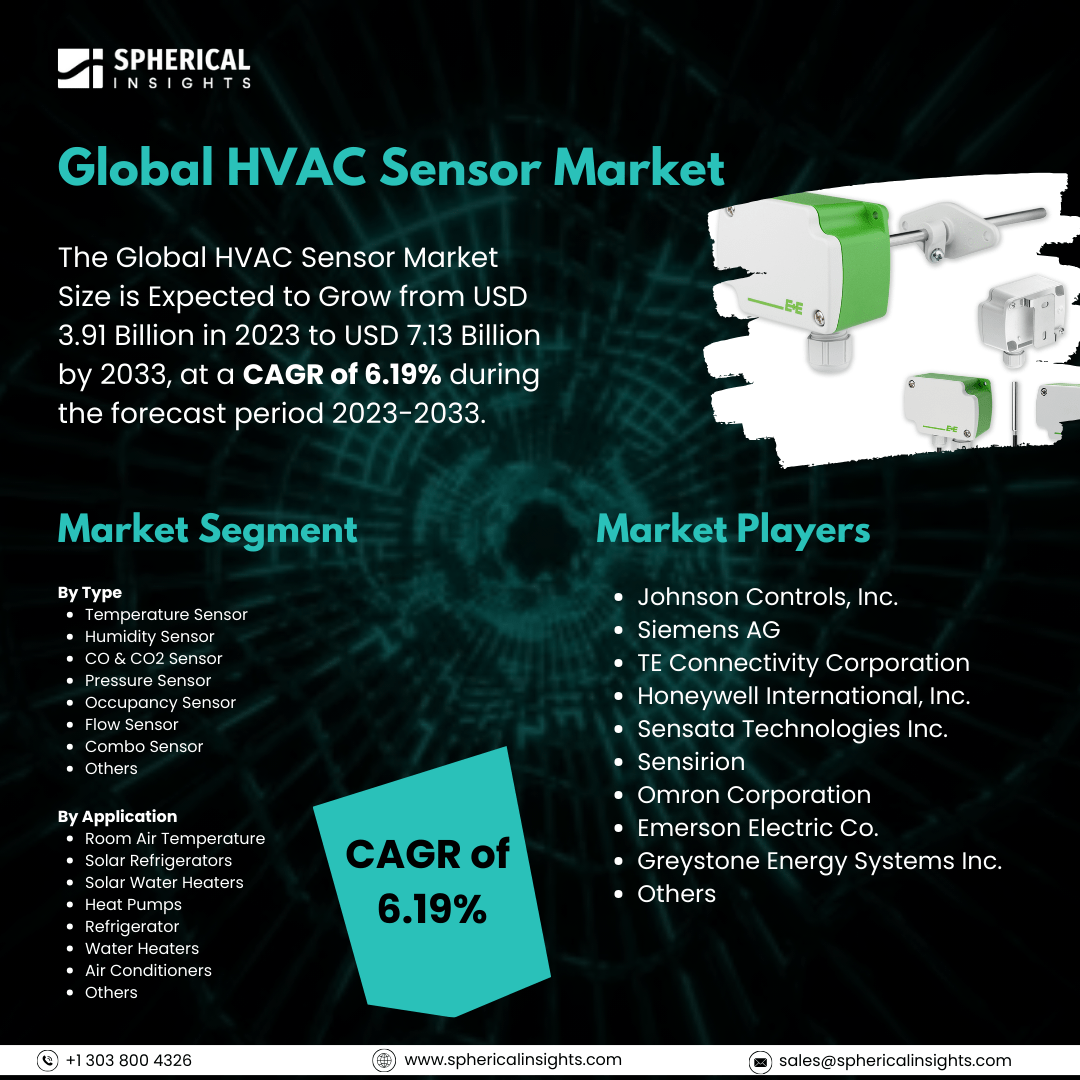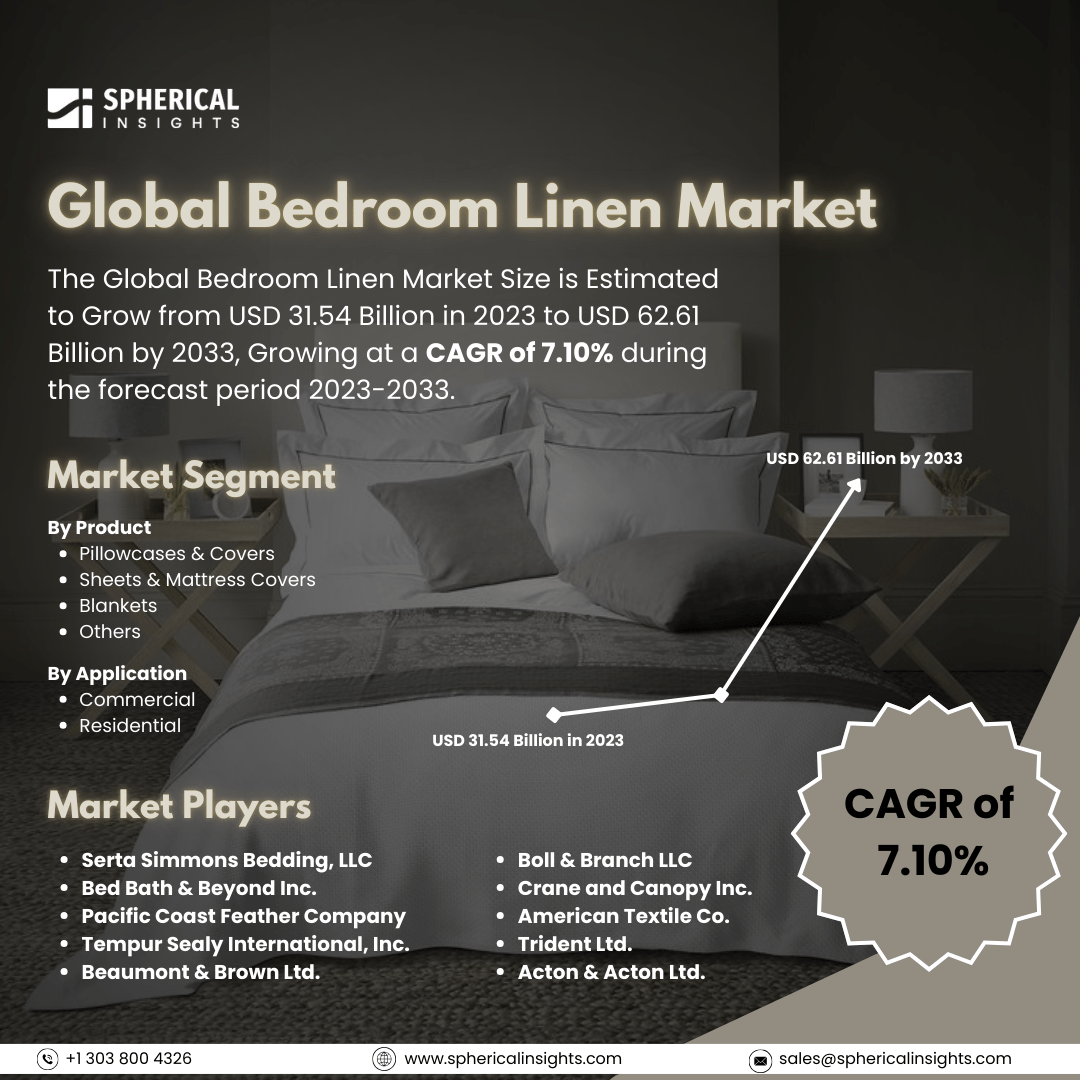Global HVAC Sensor Market Size to worth USD 7.13 Billion by 2033
According to a research report published by Spherical Insights & Consulting, The Global HVAC Sensor Market Size is Expected to Grow from USD 3.91 Billion in 2023 to USD 7.13 Billion by 2033, at a CAGR of 6.19% during the forecast period 2023-2033.
Browse key industry insights spread across 210 pages with 110 Market data tables and figures & charts from the report on the Global HVAC Sensor Market Size, Share, and COVID-19 Impact Analysis, By Type (Temperature Sensor, Humidity Sensor, CO & CO2 Sensor, Pressure Sensor, Occupancy Sensor, Flow Sensor, Combo Sensor, and Others), By Application (Room Air Temperature, Solar Refrigerators, Solar Water Heaters, Heat Pumps, Refrigerator, Water Heaters, Air Conditioners, and Others), By End Use Industry (Residential, Commercial, Transportation & Logistics, Aerospace, Automotive, Chemical, Energy & Power, Food & Beverage, Medical, and Others), and By Region (North America, Europe, Asia-Pacific, Latin America, Middle East, and Africa), Analysis and Forecast 2023 – 2033.
HVAC sensor refers to the industry for sensors used in heating, ventilation, and air conditioning (HVAC) systems. HVAC sensors monitor and regulate parameters such as air quality, temperature, and pressure in buildings. They play a critical role in maintaining comfort, air quality, and energy efficiency in residential, commercial, and industrial sectors. The surging need for increasing sensor interoperability with the Internet of Things (IoT) platform to enable remote monitoring and control in various applications including consumer electronics, automotive, medical, and industrial sectors is providing lucrative market growth opportunities. The growing construction sector and demand for HVAC sensors in the automotive sector are driving the market growth. The increase in the establishment of commercial spaces and penetration of building automation along with the increasing urbanization and industrialization are expected to drive the market demand. On the contrary, the issues related to motion-activated air conditioners are challenging the HVAC sensor market.
The CO & CO2 sensor segment is anticipated to witness the fastest CAGR growth during the forecast period.
Based on the type, the global HVAC sensor market is divided into temperature sensor, humidity sensor, CO & CO2 sensor, pressure sensor, occupancy sensor, flow sensor, combo sensor, and others. Among these, the CO & CO2 sensor segment is anticipated to witness the fastest CAGR growth during the forecast period. The sensors measure the level of carbon monoxide and carbon dioxide in the air to monitor the HVAC system’s operation and ensure the availability of the proper amount of fresh air for safety and comfort.
The air conditioners segment dominated the market with the largest market share during the projected timeframe.
Based on the application, the global HVAC sensor market is divided into room air temperature, solar refrigerators, solar water heaters, heat pumps, refrigerator, water heaters, air conditioners, and others. Among these, the air conditioners segment dominated the market with the largest market share during the projected timeframe. The requirement for smart and energy-efficient temperature control systems in both residential and business settings has increased the demand for HVAC sensors in air conditioning applications.
The automotive segment is dominating the global HVAC sensor market during the projected timeframe.
Based on the end use industry, the global HVAC sensor market is divided into residential, commercial, transportation & logistics, aerospace, automotive, chemical, energy & power, food & beverage, medical, and others. Among these, the automotive segment is dominating the global HVAC sensor market during the projected timeframe. HVAC sensors are used in automotive application for monitoring a vehicle’s temperature, humidity, and air quality in real time to provide a comfortable environment for passengers.
Asia Pacific is projected to hold the largest share of the global HVAC sensor market over the forecast period.
Asia Pacific is projected to hold the largest share of the global HVAC sensor market over the forecast period. The large client base for HVAC sensors to deploy in air conditioning, ventilation, and heating systems is driving the market for HVAC sensor. Further, the increasing number of manufacturing companies in countries like China and India due to the availability of skilled human resources is driving the regional market demand.
Europe is predicted to grow at the fastest CAGR in the HVAC sensor market over the forecast period. The strong adoption of HVAC systems in commercial buildings, homes, and the automotive sector is propelling market growth in the region. Further, the development of advanced HVAC sensors by the companies for improving the efficiency of HVAC systems is driving the market growth.
Company Profiling
Major key players in the HVAC sensor market include Johnson Controls, Inc., Siemens AG, TE Connectivity Corporation, Honeywell International, Inc., Sensata Technologies Inc., Sensirion, Omron Corporation, Emerson Electric Co., Greystone Energy Systems Inc., and Others.
Key Target Audience
- Market Players
- Investors
- End-users
- Government Authorities
- Consulting And Research Firm
- Venture capitalists
- Value-Added Resellers (VARs)
Recent Developments
- In January 2023, Lennox Industries, a trusted home comfort solutions and energy efficiency innovator for over 127 years, announced the latest additions to its industry-leading suite of smart products with the launch of the Lennox S40 Smart Thermostat and accessories, including the Lennox Smart Air Quality Monitor and the Lennox Smart Room Sensor.
- In August 2022, Levoit, the #1 selling air purifier brand in the US, launched the OasisMist Smart Humidifier, a new dual mist humidifier inspired to create any environment into a spa-like experience while promoting wellness and beauty benefits. The OasisMist offers a user-friendly design, quick-humidifying technology, and sleep mode for all seasons, and produces a continuous fine mist for up to 45 hours.
Market Segment
This study forecasts revenue at global, regional, and country levels from 2023 to 2033. Spherical Insights has segmented the global HVAC sensor market based on the below-mentioned segments:
Global HVAC Sensor Market, By Type
- Temperature Sensor
- Humidity Sensor
- CO & CO2 Sensor
- Pressure Sensor
- Occupancy Sensor
- Flow Sensor
- Combo Sensor
- Others
Global HVAC Sensor Market, By Application
- Room Air Temperature
- Solar Refrigerators
- Solar Water Heaters
- Heat Pumps
- Refrigerator
- Water Heaters
- Air Conditioners
- Others
Global HVAC Sensor Market, By End Use Industry
- Residential
- Commercial
- Transportation & Logistics
- Aerospace
- Automotive
- Chemical
- Energy & Power
- Food & Beverage
- Medical
- Others
Global HVAC Sensor Market, Regional Analysis
- North America
- Europe
- Germany
- Uk
- France
- Italy
- Spain
- Russia
- Rest of Europe
- Asia Pacific
- China
- Japan
- India
- South Korea
- Australia
- Rest of Asia Pacific
- South America
- Brazil
- Argentina
- Rest of South America
- Middle East & Africa
- UAE
- Saudi Arabia
- Qatar
- South Africa
- Rest of Middle East & Africa



